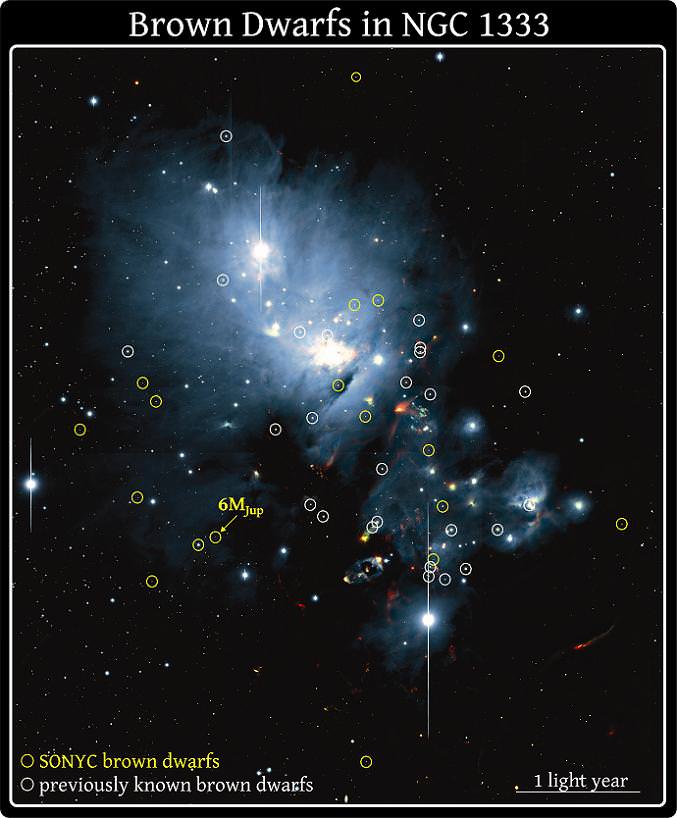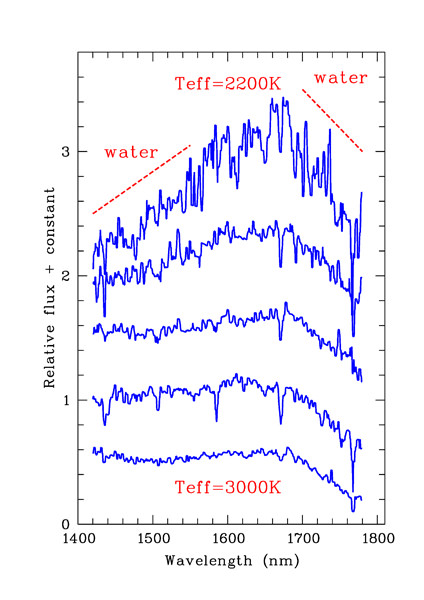University of Toronto | 2011 Oct 11
One youngster only six times heftier than Jupiter
A University of Toronto-led team of astronomers has discovered over two dozen new free-floating brown dwarfs, including a lightweight youngster only about six times heftier than Jupiter, that reside in two young star clusters. What's more, one cluster contains a surprising surplus of them, harbouring half as many of these astronomical oddballs as normal stars.
- [i]Brown dwarfs in the young star cluster NGC 1333. This photograph combines optical and infrared images taken with the Subaru Telescope. Brown dwarfs newly identified by the SONYC Survey are circled in yellow, previously known brown dwarfs are circled in white. The arrow points to the least massive brown dwarf known in NGC 1333: it is only about six times heftier than Jupiter. (Credit: SONYC Team/Subaru Telescope)[/i]
"Our findings suggest once again that objects not much bigger than Jupiter could form the same way as stars do. In other words, nature appears to have more than one trick up its sleeve for producing planetary mass objects," says Professor Ray Jayawardhana, Canada Research Chair in Observational Astrophysics at the University of Toronto and leader of the international team that made the discovery.
Brown dwarfs straddle the boundary between stars and planets. Sometimes described as failed stars, they glow brightly when young, from the heat of formation, but cool down over time and end up with atmospheres that exhibit planet-like characteristics. Scientists think that most brown dwarfs may have formed like stars, in isolation from contracting gas clouds, but some of the puniest free-floaters may have formed like planets around a star and later ejected.
The findings come from observations using the Subaru Telescope in Hawaii and the Very Large Telescope (VLT) in Chile during the Substellar Objects in Nearby Young Clusters (SONYC) survey. Astronomers took extremely deep images of the NGC 1333 and rho Ophiuchi star clusters with Subaru at both optical and infrared wavelengths. Once they identified candidate brown dwarfs from the very red colors, the research team confirmed them with spectra taken at Subaru and the VLT. The team's findings will be reported in two upcoming papers in the Astrophysical Journal and presented this week at a scientific conference in Garching, Germany.
The six-Jupiter-mass brown dwarf found in the NGC 1333 cluster is one of the least massive free-floating objects known. "Its mass is comparable to those of giant planets, yet it doesn't circle a star. How it formed is a mystery," said Aleks Scholz of the Dublin Institute of Advanced Studies in Ireland, lead author of one paper and a former postdoctoral fellow at the University of Toronto.
Several other newly identified brown dwarfs in both NGC 1333 and rho Ophiuchi clusters have masses below 20 times that of Jupiter.
"Brown dwarfs seem to be more common in NGC 1333 than in other young star clusters. That difference may be hinting at how different environmental conditions affect their formation," says University of Toronto’s Koraljka Muzic, lead author of the second paper.
"We could not have made these exciting discoveries if not for the remarkable capabilities of Subaru and the VLT. Instruments that can image large patches of the sky and take hundreds of spectra at once are key to our success," said co-author Motohide Tamura of the National Astronomical Observatory of Japan.
Other co-authors of the two papers are Vincent Geers of ETH Zurich in Switzerland, also a former UofT postdoc, and Mariangela Bonavita of the University of Toronto.
"Failed Stars" Galore with One Youngster Only Six Times Heftier than Jupiter
NAOJ Subaru Telescope | 2011 Oct 11
An international team of astronomers has discovered over two-dozen new free-floating brown dwarfs that reside in two young star clusters. One brown dwarf is a lightweight youngster only about six times heftier than Jupiter. What's more, one cluster contains a surprising surplus of brown dwarfs; it harbors half as many of these astronomical oddballs as normal stars. These findings come from deep surveys and extensive follow-up observations using the Subaru Telescope in Hawaii and the Very Large Telescope (VLT) in Chile, two of the world's largest optical-infrared telescopes.
- [i]Spectra of several brown dwarfs in the young star cluster NGC1333, taken with FMOS instrument on the Subaru Telescope. The spectra show a characteristic peak around 1670nm. Water steam in a brown dwarf's atmosphere absorbs radiation on both sides of the peak. The plot shows that the strength of the water absorption increases in cooler objects (from 3000 to 2200K). (Credit: SONYC Team/Subaru Telescope)[/i]
Sometimes described as failed stars, brown dwarfs are unusual celestial objects that straddle the boundary between stars and planets. When young, they glow brightly from the heat of formation, but they eventually cool down and end up with atmospheres that exhibit planet-like characteristics.
During the course of the SONYC (Substellar Objects in Nearby Young Clusters) Survey, astronomers used Subaru Telescope to take extremely deep images of the NGC 1333 and rho Ophiuchi star clusters at both optical and infrared wavelengths. Once they identified candidate brown dwarfs from their very red colours, the research team verified their nature with spectra taken at Subaru and the VLT. The team's findings are reported in two upcoming papers in the Astrophysical Journal and will be presented this week at a scientific conference in Garching, Germany.
The six-Jupiter-mass brown dwarf found in the NGC 1333 cluster is one of the puniest free-floating objects known. "Its mass is comparable to those of giant planets, yet it doesn't circle a star. How it formed is a mystery," said Aleks Scholz of the Dublin Institute for Advanced Studies in Ireland, lead author of the first paper.
Several other newly identified brown dwarfs in both NGC 1333 and rho Ophiuchi clusters have masses that are less than 20 times the mass of Jupiter-placing them at the low end of the mass range for known brown dwarfs. "Brown dwarfs seem to be more common in NGC 1333 than in other young star clusters. That difference may be hinting at how different environmental conditions affect their formation," said Koraljka Muzic of the University of Toronto in Canada, lead author of the second paper.
"Our findings suggest once again that objects not much bigger than Jupiter could form the same way as stars do. In other words, nature appears to have more than one trick up its sleeve for producing planetary mass objects," said Ray Jayawardhana of the University of Toronto, who is the principal investigator of the SONYC Survey.
"We could not have made these exciting discoveries if not for the remarkable capabilities of Subaru and the VLT. Instruments that can image large patches of the sky and take hundreds of spectra at once are key to our success," said Motohide Tamura of the National Astronomical Observatory of Japan.
Other co-authors of this work are Vincent Geers of ETH Zurich in Switzerland and Mariangela Bonavita of the University of Toronto.
Substellar Objects in Nearby Young Clusters (SONYC) IV: A census of very low mass objects in NGC1333 - Aleks Scholz et al
- arXiv.org > astro-ph > arXiv:1110.1639 > 07 Oct 2011
- arXiv.org > astro-ph > arXiv:1110.1640 > 07 Oct 2011
Free Range Brown Dwarfs
Universe Today | Tammy Plotner | 2011 Oct 12

